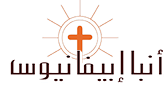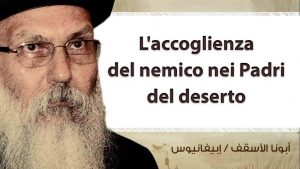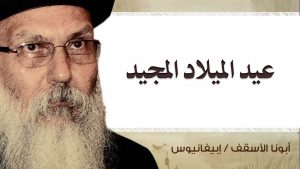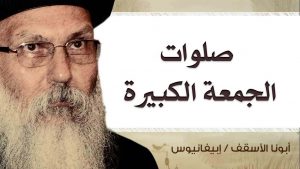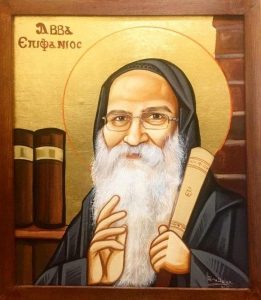The Human & Spiritual Legacy of Father Matthew the Poor
(Matta’l Meskeen)
The Human and Spiritual Legacy of Father Matthew the Poor
Your Grace Bishop Suriel,
Reverend Fathers, Ladies and Gentlemen:
I would like to thank His Grace Bishop Suriel for inviting me to participate in this symposium, and I would also like to thank the organizers for suggesting that I present on the human and spiritual legacy of the contemporary monastic father, Father Matta ’l Meskeen.
First of all, I would like to convey the greetings and blessings of H. H. Pope Tawdoros II, Patriarch of Alexandria, to all of you, as well as his prayers for the success of this symposium.
Father Matta was a prominent Coptic figure, who not only influenced the progression of monastic life but also greatly effected Patristic and Biblical studies at large. His impact is still felt in the church; both in Egypt and abroad[1].
Fr. Matta was born in 1919, he reposed in 2006, at the age of 87 years. He was the spiritual father of the Monastery of St Macarius in the Wadi’n Natroun, which is located in the western desert of Egypt. He left for his sons a valuable human and spiritual inheritance from which we are still nourished without ever claiming to be fully able to apprehend it.
His Background
Prior to the pharmacist “Youssef Iskandar” devoting his life to the monastic vocation in 1948, there were 2 events which had a powerful effect on his future life. The first event was when he visited some Sunday-school teachers from the province of Giza in the south of Cairo. At this gathering of Sunday School teachers, one of those attending enquired concerning the salvation of those who are non-Orthodox. To Youssef Iskander’s surprise, one of the attendees answered negatively! And this negative response caused him great sorrow, and from that point, he realized the importance of understanding the faith and history of other denominations, and indeed it was an aspect that impacted the entire life of Fr. Matta.
The second event was when he visited the Archdeacon Habeeb Girgis in his home. And although Fr Matta did not discuss details of this visit, in his own words he said that the purpose of his visit to Habib Girgis was “to receive his blessings before leaving for the monastic life.” This statement alone is testimony of the high regard young Coptic youth had for Habib Girgis, for they saw him not only as an esteemed church leader, but a spiritual elder who could be entrusted with the inner most desires of their spiritual life[2].
Indeed, there is much that can be said about Fr Matta, but for the sake of time, I will limit my discourse to 4 points that I personally believe have left the most powerful impression on us insofar as his life and writings are concerned.
1: Fr. Matta and Monastic Renewal
When Fr. Matta began his monastic life in 1948, Coptic monasteries were in a pathetic state. The number of monks had drastically decreased and some of the monasteries’ buildings were on the verge of collapsing—especially that of St Macarius. It was impossible to find among the monks of his day, university graduates, and with very few exceptions, it was near impossible to find monks who devoted themselves to Coptic or Biblical studies.
Fr. Matta began his monastic life as a novice being apprenticed to the solitary monk, Fr. Mina, who was later enthroned as Pope Cyril VI. At that time, Fr Mina was in charge of the monastery of St Samuel the Confessor in the desert of Qalamoan in Middle Egypt, and it was there that Fr. Matta was consecrated a monk. For the 3 subsequent years that he was at this monastery in Qalamon, he dedicated his entire nights to prayer, Bible readings, and meditations on the sayings of one of the early monastic fathers, such as St Antony, St Macarius or St Isaac the Syrian. In fact, through his contemplations, he would feel a strong emotional tie that linked him to their spirits during the night, that he would feel them communicating with him concerning the things they had experienced[3].
However, in 1951, due to his declining health, Fr Matta was forced to move to the Coptic Monastery of the Syrians in Wadi’n Natroun. There, he mentored many of the educated monks who were a nucleus to the modern monastic movement which emerged in Egypt in the middle of the 20th century. Most famous among these young monks were Fr. Antonios el syriany (who was later enthroned as Pope Shenouda III), Fr. Shenouda el syriany (who became Bishop Youannes of the Gharbia province in the Nile delta), Fr. Cyril el Maqary, and Fr. Mina el Maqary, (the first one of them who began his monastic life, and the only one who is still alive). From his solitary retreat in a cave, father Matta would send these monks periodical letters of direction for their spiritual life, and from the nature of his letters it was clear that his teachings were greatly influenced by the early desert fathers.[4]
Then some years later, in 1960, Fr. Matta, together with some of his monks, moved to the region of Wadi’ r Rayyan, which is located 60 km from the Fayyoum. It was here that for 10 years he lived a complete eremitic life in a cave. Indeed, it was ever since his first day of his monastic life, that he determined to lead a life based on the commandments of the gospel and the example of the desert fathers, especially St Antony, St Macarius and St Pachomius. It was during these years that he produced a literary work entitled, St Antony: An Evangelical Ascetic, in which he highlighted the evangelical basis of the monastic life, and without which we would deviate from the correct path.
Then in 1969, at the request of Pope Cyril VI, he relocated, together with his disciples, from Wadi’r Rayyan to settle in the monastery of St Macarius in the Wadi’n Natroun, where he began rebuilding the monastery both structurally and spiritually, until it became a spiritual and scholarly lighthouse that hence attracted many young men wishing to lead a monastic life.
Fr Matta began to revive the early monastic semi-eremetic life of Scetis that was a harmonious blend of both eremitic and coenobitic systems, that was based on the examples of St Macarius and also St Pachomius. Fr Matta was the first to revive the daily Agape meal in Coptic monasteries, where according to genuine monastic tradition, monks gather together around the bread of love. Father Matta taught that common meals in the refectory are an extension of the Eucharist, and so he revived a tradition that had disappeared from our monasteries for hundreds of years.
Another aspect he propagated was the importance of common manual labour as necessary for all monks who are able to work, and he based this rule according to that stipulated by the early monastic fathers, in particular St Antony and St Pachomius, that monks should be self-sufficient, and anything extra is to be given to the poor.
2: Fr. Matta and his Openness toward the Universal Church
Orthodox Prayer Life was the first book Fr Matta published in 1952—only 4 years after his devotion to the monastic life. So great was its influence that the metropolitan George Khodr of Mount Lebanon commented that “for the first time in the modern era are Greek Orthodox taught by a Copt.”
This book is not merely a research on the origins of Orthodox spirituality, but a window through which Copts can look back on their spiritual, patristic and monastic past. It greatly impacted the lives of thousands of Copts, many of whom later became church leaders, and because of its influence on monastic movements outside of Egypt, it was translated into English[5], French, German, Italian, Ukrainian and Hungarian.
Perhaps one of the most important features of this book, which had remained unfelt by us for a long time, was the inclusion of sayings attributed to non-Coptic saints from the universal church; saints such as St Gregory the Great, St John Damascene, St Seraphim of Sarov, of whom the Coptic Church knew very little or even nothing about. Their inclusion in this book shed light for us on churches that we had regarded for many centuries as being hostile to the Coptic Church. What we had discovered was that we were in fact reading and living the lives and sayings of these Universal Church saints. Willingly and gladly we read and followed their examples together with those of our own, and we came to realize that this was an ecumenical sign and action of knowing and accepting others; an aspect which is still sadly unaccomplished through ecumenical dialogue[6].
Fr. Matta realized the aforementioned facts at his time; and so in his preface to the 2nd edition of his book in 1968, he wrote, commenting on the words of metropolitan George Khodr: “God has chosen this book to be a word of reconciliation and a meeting point, not at the level of intellectual or theological debates, but at that of the unity of spiritual life and the manifestation of faith which exceeds our verbal disability into the light of the lived, divine truth.”
Perhaps one of the fruits of this openness and mutual understanding, are the strong bridges that have been built between the monastery of St Macarius and many other monasteries in the west, such as Chevetogne in Belgium, Bose in Italy and the Brotherhood of Taizé in France.
3: Fr. Matta and Church Education:
During the first half of the 20th century, there arose in Egypt a Sunday school movement led by Archdeacon Habeeb Girgis. When Habeeb Girgis founded his movement, he found nothing on his Arabic bookshelf in Egypt except some of the dialectic or Biblical works which came across from other churches. Nothing was known about patristic or Biblical studies to the Coptic reader in Arabic except some books that were translated from Protestant authors.
Perhaps the first writings to gain some popularity among Coptic readers were those of Habeeb Girgis, in addition to some homilies and sermons taken from Arabic MSS kept in the libraries of ancient monasteries and churches.
The first meeting between Fr. Matta and the Coptic congregation occurred when he was appointed a deputy of Pope Youssab, (who resided in Cairo) for the city of Alexandria in 1954[7]. It was at this point that he thus began to educate the people. One of the fruits of his sermons was his impressive book Meditations on Holy Week which gained great popularity in the church for presenting the incidents of the Passion of our Lord in a new spiritual way, that was unfamiliar at that time to Coptic ears, so much so, that the prayers contained at the end of these sermons came to be printed later in the book of canonical hours which is common now in the Coptic church.[8]
The writings of Fr. Matta propelled a remarkable change in the education of the Coptic church. The change being that he was not influenced by biblical Commentaries that were mostly translations of the works of western scholars; for these commentaries were available in Egypt at that time, but rather, he acquired the entire series of patristic texts that were translated into English[9]. And these texts he read passionately. As a result, the thoughts of the patristic fathers were thus impressed on his own mind, and so his life became permeated with the lives of the church fathers. Thus it comes as no surprise that the writings of Fr Matta were infused with those of the patristic fathers, and so for the first time in the modern history of the Coptic church we were given literature about the indwelling of the Holy Spirit and His role in leading us in our spiritual labor.
It is on account of these writings that the notion of spiritual labor has changed in the monastic life. Monastic asceticism became the fruit of the action of the Holy Spirit within us, and spiritual labor became an offering we daily submit to God in gratitude for the redemption we have acquired as a result of the sacrifice of the cross. Isn’t that exactly what St Antony the Great calls for in his letters and sayings to his monastic sons?
The same goes for Fr. Matta’s notion concerning church feasts. The nativity of the Lord Jesus is the birth of the new person. His baptism and the descent of the Holy Spirit upon Him in the Jordan River is the baptism of the new creation and its reconciliation to God in order to accept the permanent dwelling of the Holy Spirit within it. The cross of the Lord is our own cross, for we are united to Him. Consequently, when He arose from the dead we were all resurrected in Him. Fr. Matta often recited the words of the Apostle Paul: “I have been crucified with Christ”; “He raised us up with Him and seated us with Him in the heavenly places”. Isn’t that the notion of the incarnation and redemption as explained by the fathers and saints of the church? [10]
Fr Matta also composed several expositions and commentaries in which he presented to the reader spiritual explanations and interpretation of Biblical texts based on firm linguistic and scholarly knowledge. He adorned this knowledge with the precious interpretations of the early Church fathers, and provided references to valid contemporary scholarship. His work was then complimented with what God had inspired within him. The resulting commentaries became a meeting place for spiritual knowledge around the Biblical text that transcended time (the fathers) and place (contemporary scholars).
Fr Matta gave great care to hand down to those who would follow after him, whether monks or laymen, the encouragement to explore his style of exegesis, and to study ancient languages such as Hebrew and Greek[11]. He also paid great effort to populate the monastery library with many books; many of which contain patristic and biblical exegesis.
Patristic concepts penetrated all the writings of Fr. Matta; and thus they appeal to the Christian reader regardless of denomination. Through his heart felt writings, the reader at once feels they are able to relate the words to their own self. Once more an unofficial church unity is sensed by all readers on account of these writings. As his sons, we have felt this unity of friendship which has been formed between us and all Christian denominations. It is also felt through the spirit of love we encounter in our brethren in other churches whenever we travel abroad.
4: Fr. Matta and Christian Unity
In 1965 Fr. Matta wrote a booklet titled Christian Unity. He filled it with his thoughts and understanding on the notion of Christian unity and how it is to be achieved. He emphasized that we don’t need an emotional unity to add to man’s glory and self-veneration—like what he did in ancient times when he tried to build the tower of Babel, that resulted in his own disintegration and division. Neither do we need a unity based on blocks where the weak gains strength by sticking to the strong—and so the strong thus becomes stronger and more powerful.
What we need is a unity at the divine level; a sure result of man’s union with God. This is an outcome of God’s first commandment: You shall love the Lord your God with all your heart with all your soul and with all your mind; and the second commandment as well: You shall love your neighbor as yourself. The second commandment is based on the first; and without it, it has no value.
Fr. Matta says: “The road to union with God is not a one-way street ending solely with God; on the return journey it leads back to one’s neighbor, the stranger, one’s enemy, and toward all creation. He who unites himself to God undertakes to consider how he should unite himself to all and takes no rest until that union has been accomplished”[12].
In 1972 Fr Matta wrote an article for the Greek Orthodox Lebanese journal Al-Nour where he says: “The lack of integrity with respect to the catholicity and unity of the Church, until now, among the Churches of the world does demand of us—not reconsidering our theology, for our theology is true and faithful—to reconsider ourselves in view of our correct theology so that we might correct our vision of God the only Father of all humankind, and correct our view of Christ as the only Savior and the only Redeemer of all who call on His name, through whom is indiscriminately adopted the whole of humanity by God, thus correcting our love toward man—every person—as being inevitably a brother to us, even if he stood against us in hostility”[13].
He then goes on to mention in a booklet he wrote in 1984, the practical steps to be taken along the road to unity without sacrificing our doctrine. The booklet is titled True Unity Will Inspire the World, where he suggests in a simple manner the positive steps to be taken if unity between Chalcedonians and non-Chalcedonians is to be achieved.
The first step is to simultaneously lift all the excommunications by each church for the other, because such excommunications are against the will of the Holy Spirit, and took place in ignorance of each church of the other’s spirit and conscience, while sticking to the letter instead of the Spirit.
The second step is the mutual and simultaneous recognition of each church’s doctrine by the other in terms of its essence and not its words; that is to say, on the basis of the necessity of salvation and eternal life, which each doctrine makes feasible through Jesus Christ who works in both denominations in the same way, despite the variation of texts.
The third step consists in holding a discussion on terminology and clearing any vagueness by means of explanation and not by deletion or addition to the items of the doctrine which have been handed down literally through the tradition of each church, in order to provide a formula of reconciliation that suits a unity of communion and Spirit, without harming anything that belongs to the history of dogma or its ramifications so far as literature or councils are concerned.
Fr. Matta believed that Christian unity is achievable, not through ecumenical dialogue in the first place, but by means of the saints of each church, i.e. their pious people, whose prayers and life would inspire the leaders of every church with what would help them realize this unity.
And what is our meeting today other than a prototype of the church of Christ which He desires “:… that they all may be one, as You, Father, are in Me, and I in You; that they also may be one in Us, that the world may believe that You sent Me” ( John 17:21).
***
[1] ΑΘΑΝΑΣΙΟΥ ΔΗΜΗΤΡΙΟΣ, Οι Κόπτες μεταρρυθμιστές του 20ού αιώνα και η θεολογία τους
ΜΕΤΑΠΤΥΧΙΑΚΗ ΔΙΠΛΩΜΑΤΙΚΗ ΕΡΓΑΣΙΑ, ΠΑΤΡΑ , ΟΚΤΩΒΡΙΟΣ, 2015 p. 4.
[2] Cf, Bishop Suriel, Habib Girgis Coptic Orthodox Educator and a Light in the Darkness, SVS 2017, p. 31.
[3] Anthony O’Mahony, Tradition at the Heart of Renewal: the Coptic Orthodox Church and Monasticism in Modern Egypt, International Journal for the Study of the Christian Church, Vol. 7, No. 3, August 2007, p. 168.
[4] The Letters of Fr. Matta’l Meskeen, 1st edition 2006, Letters 1-5 (in Arabic).
[5] Orthodox Prayer Life: The Interior Way, St Vladimir’s Seminary Press, Crestwood, New York, 2003;
L’expérience de Dieu dans la vie de prière, Coll. Spiritualité Orientale, no 71, Bellefontaine, 1997;
L’esperienza di Dio nella preghiera, Edizioni Qiqajon, Comunità di Bose, 1999;
DIE ERFAHRUNG GOTTES IM LEBEN DES GEBETS, Verlag „Der Christlichen Osten“ GmbH, Würzburg, 2007, Schriftleitung: P. Dr. Gregor Hohmann OSA, Dietmar Süssner, Grabenberg 2a, D-97070 Würzburg;
Молитовне життя Східної Церкви (Translated from Orthodox Prayer Life)
Пер. 3 англ. О. Мельник. – Львів: Ϲвічадо, 2011.ϲ. © Видавництво «Ϲвічадо», українське видання, 2011;
Isten Megtapasztalasa Az Imaban (Translation of Orthodox Prayer Life, from the Italian), Szent Jeromos Katolikus Bibliatarsulat (Budapest) , 2016, ISBN 978-963-9921-12-2.
[6] Jos M. Strengholt, Unity of the Church: Father Mattá al-Miskin and the Coptic-Orthodox Church in the Ecumenical process, Cairo, Egypt (2009) p. 6.
[7] Wolfram Reiss, Renewal in the Coptic Orthodox Church; Ph.D. thesis, Publishers: Religious News Service from the Arab World, 2002, p. 189.
[8] Kitab Al-Agbiah (Horologion), Diocese of Beni-Sueif: Prayers for meditation on the Passion, death and resurrection of the Lord; Al-Agbiah, The Youth of the Church of St Antony, Abu-Dhabi, 2003; The Book of the Seven Prayers, Maktabat-Almahaba, Shoubra, Egypt…(الأجبية، كتاب السبع صلوات، طبعات مطرانية بني سويف، مكتبة المحبة، شباب الأنبا أنطونيوس بأبو ظبي…).
[9] Wolfram Reiss, Renewal in the Coptic Orthodox Church; Ph.D. thesis, Publishers: Religious News Service from the Arab World, 2002, p. 191
[10] Stephen J. Davis, Coptic Christology in Practice, Incarnation and Divine Participation in Late Antique and Medieval Egypt, Oxford Early Christian Studies, Oxford University press (2008) p. 273.
[11] Christiane Rathle, The Desert Militants, Change and Modernizing Factors in Coptic Monasticism, A Thesis Presented to the Sociology- Anthropology Department in Partial Fulfillment of the Requirements for the Master of Arts Degree, The American University in Cairo, May 1987, p. 78.
[12] Matthew the Poor, “Christian Unity” in The Communion of Love, St. Vladimir’s Seminary Press, 1984, p. 227.
[13] Matthew the Poor, “One Christ and One Catholic Church” in The Communion of Love, St. Vladimir’s Seminary Press, 1984, p. 221.
